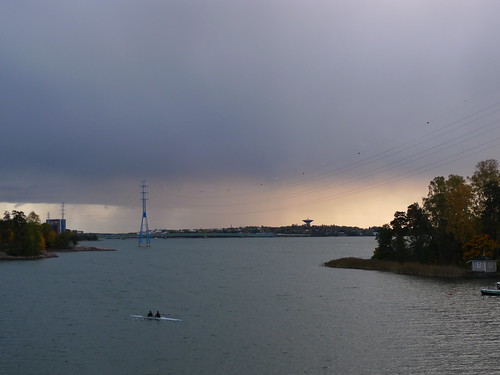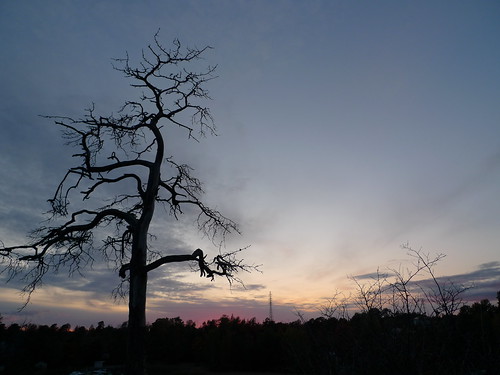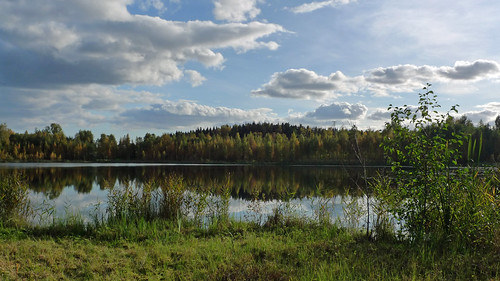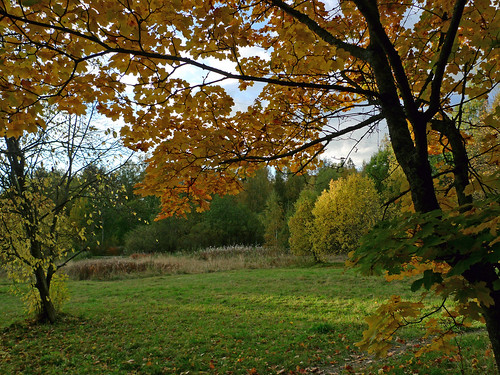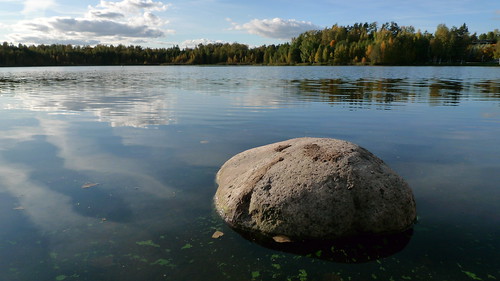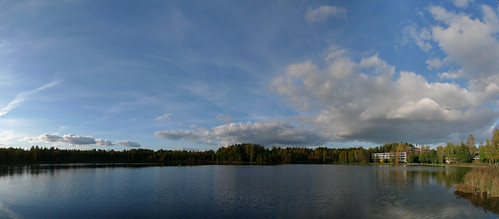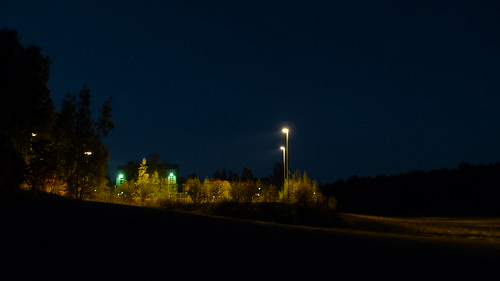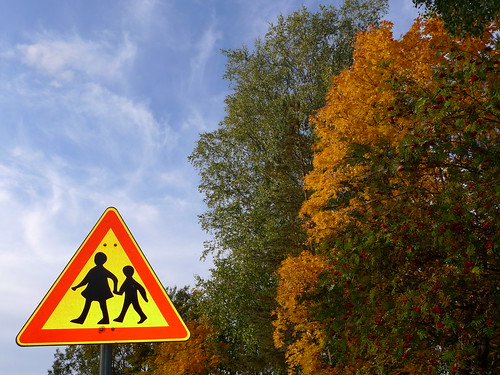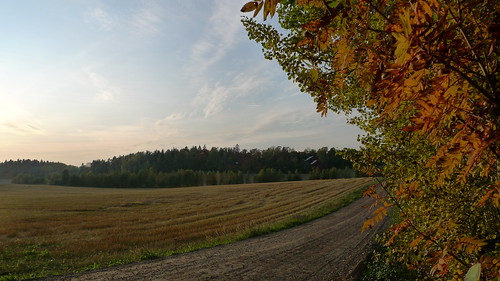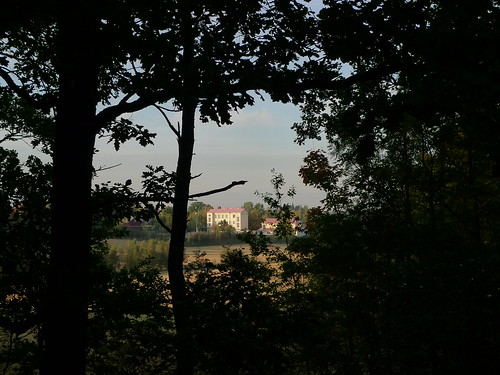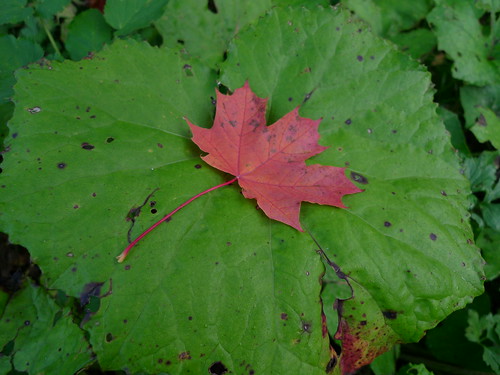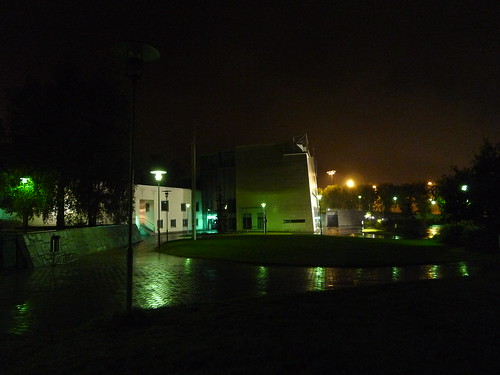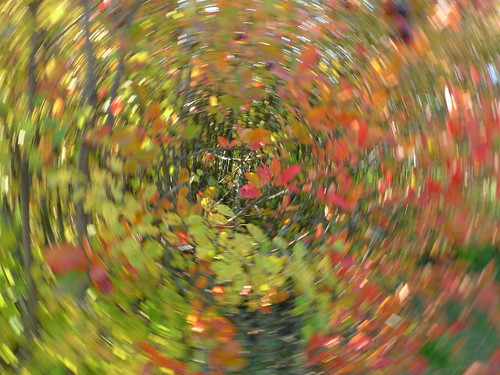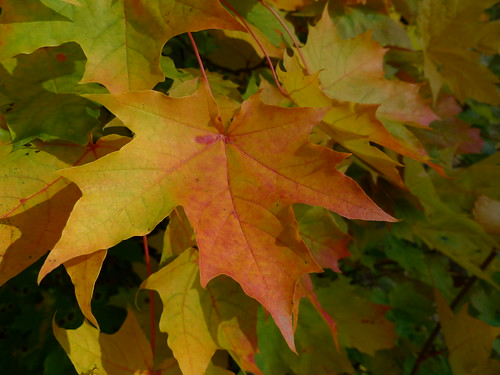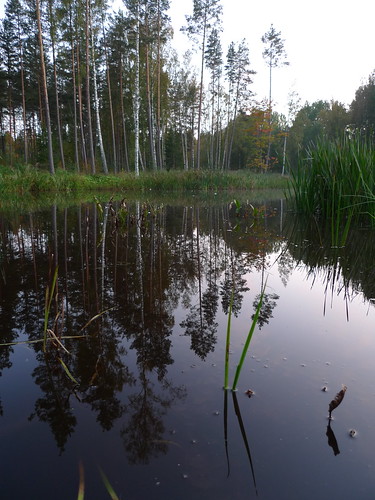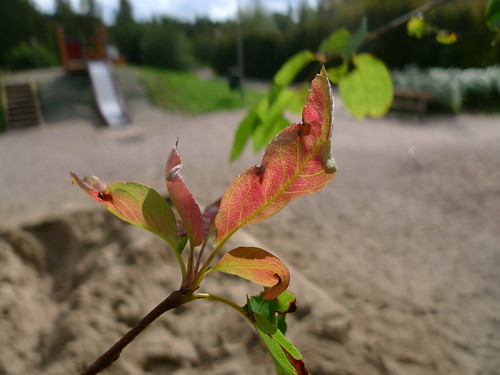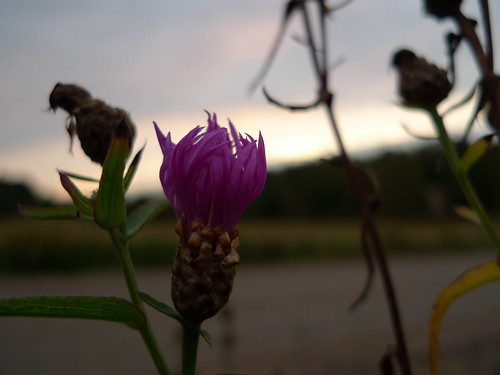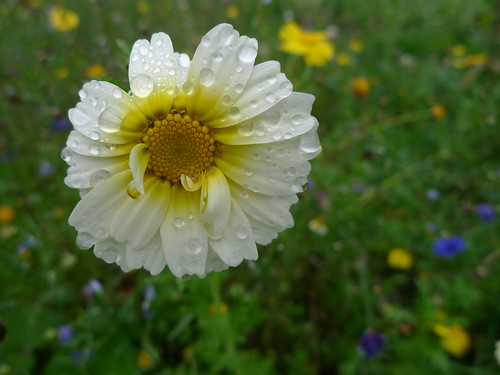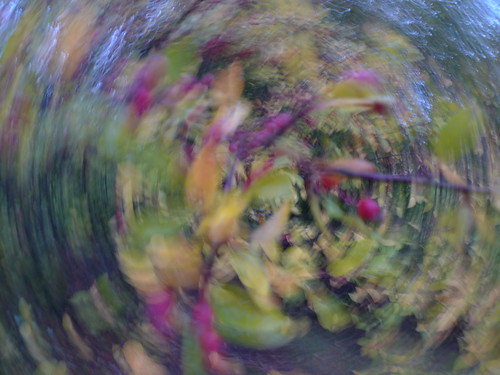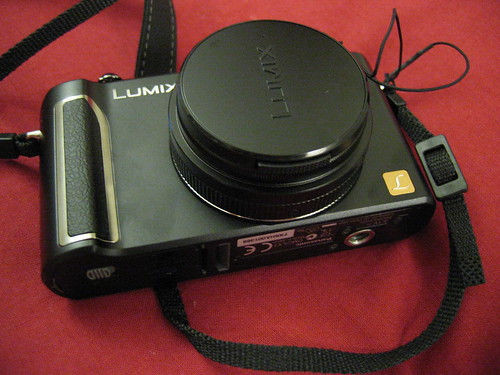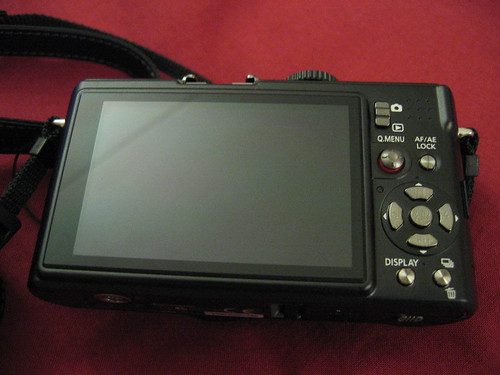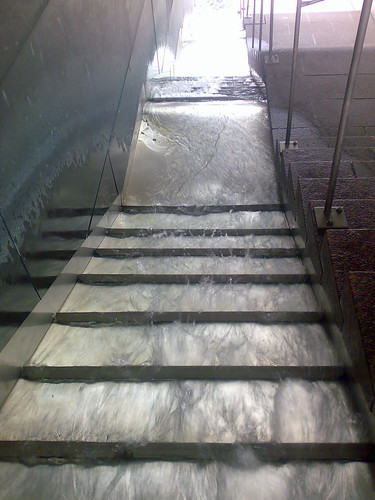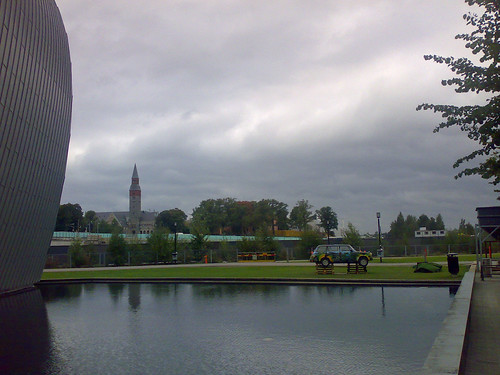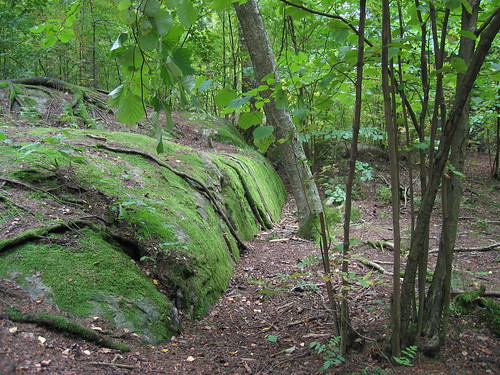What a day! During the night we had below zero temperature, so in the morning there was a lot of frost, which stayed on quite late. But then it got quite warm and sunny. During the afternoon we got clouds and some rain showers, and at one point it even looked like there would be a storm.
Tuesday, September 30, 2008
Aperture priority and Panasonic LX3
I read an excellent posting at Doonster, titled Panasonic Lumix LX3: further observations, describing how to use the LX3 with manual focusing, using f/4 to get hyperfocal. I tried this today, and it worked well, although I forgot a few times to check the focusing distance before shooting.
Here is the hint from doonster: "I use the focus button when I want AF. Works well and is far more ergonomic that using AF and the AF-lock button. Also mean I can pre-focus or focus and re-compose with ease."
This is really convenient, and there is no shutter lag to speak of with this. The only drawback is the need to remember that you are no longer in autofocus, so you need to use the focus button before shooting.
Manual focusing works quite well, and you are really in control of what you are doing. The LX3 shows the depth of field as a yellow bar on the display. I was mainly using f/4 (and f/8 with the tele end of the lens) to get enough DoF in my shooting, and this worked well.
I tried once again b&w photography with the LX3, using the "dynamic b&w" film mode. I'm not quite sure whether I like this in all cases, but here it seemed to do a competent job. Here I actually used f/5, I'm not quite sure why.
Update: I noticed that Doonster had another nice posting, about "how good" you are at something. I feel that there is no single answer.
My main occupation has centered around writing for a long time, and every once in a while I have felt that my skills have been going downhill. And I guess that has once in a while been also true by some arbitrary measure. But later on I have realised that these "detours" have been necessary to find something new, which has in fact then helped to improve the skills by a big step.
Photography is such a nice hobby for a novice like me that there is so much to learn. Thus you keep improving (or feel that you are improving) despite failing all the time. Without failure, no progress.
Yet another lake panorama
I don't know what it is about these panoramas, but I like doing them. This time I had learned something new about the LX3. I was using manual focusing (hyperfocal), aperture priority, and exposure lock. And even though I got the sun in the image, I feel that the result is quite nice. A relaxing hobby, making of panoramas.
Monday, September 29, 2008
Sunset reflection
This is the Biomedicum building at Meilahti (Helsinki), photo taken at sunset today. I liked the colors reflected from the windows - the actual sunset was much more modest.
It would be possible to correct the vertical lines in software, but I feel I like this photo as it is. Taken with the Panasonic LX3 using the wide end of the lens (24 mm equiv.).
I have gotten so used to taking photos (and having a walk outside at the same time), that days when this is not possible (heavy rain etc.) are almost unbearable. But I feel this is not a dangerous addiction, at least not yet. In fact, I feelt that photography has great deal of remedial value. As of course has the Biomedicum building.
Night feelings
This evening I went for another walk with the children, this time by the sea, at the Meilahti region in Helsinki. It was sunset, not one of the most spectacular, but worth watching nevertheless. However, very few people were watching it, although many people were out jogging, riding a bicycle or otherwise getting exercise.
Quilty pleasures
Even though the last few days have been full of worry, with some bits of fear mixed in, I took today an opporturnity to take a couple of photos, while walking outside with the children.
This dried up berry pretty much sums up my feelings. But I felt that you have to continue with the normal routines, even some pleasures, although the life around you is shaking at foundations.
Personal worries aside, my opinion piece on societal issues in Finland appeared today in the Helsingin Sanomat newspaper. The title (given by the editors, the original was quite provocative) was "The human being is forgotten in the innovation society" (in Finnish, "Innovaatioyhteiskunnassa ihminen unohtuu").
As I'm not subscribing to the magazine (though it is the biggest in Finland), and didn't have time to look at it while at work, I'm a bit unsure of how much editing was done to the text. (The web archive of HS only shows a few sentences from the beginning.) However, I received a couple of comments which seem to indicate that the editors hadn't made big censorship to the text.
Update: While writing this I got a spam mail with the title "Bigger Your Penis and Save $xxx". If only life would be so easy to fix.
Sunday, September 28, 2008
Good night
I have for a while looked at this concrete wall and wondered the reddish tint on it. Now there seems to be an explanation for it: the rose bushes turned red. It seems that some of that leaf color is making an impact on the gray concrete, and that color stays there all the year round. Greenery which turns red which turns the concrete red.
About panoramas and brochures
It seems that I'm really into lake panoramas, here is another one from today. It was quite windy, and later we got a bit of rain also.
Some time ago I speculated on the premise of camera brochures: "Are the camera manufacturers still printing (on art paper) beautiful brochures of their products? [...] As a teenager, I browsed through the brochures (Canon, Minolta, Pentax, ...), time after time comparing all the tinyest details between the models. Nowadays people of course use the net for the comparisons."
Now a visitor to Photokina 2008 did not get brochures, as told in the posting Nikon too stingey to give out proper brochures: "I got the Nikkor lens brochure, but for the D700 all I got was a Cd-rom with the D700 brochure in digital form! Thats all they were giving out to people interested in buying their D-SLR's. That is a piss poor effort for Nikon, and at the major European showcase of the year for their products. Very, very dissapointed."
So it seems that the demise of the brochure is upon us. Actually, one reason why the camera companies (and many others) don't offer brochures here in Europe is the increasing demand for environment-frienly operations. For example in Germany it is frowned upon if you destroy forests by printing glossy advertising material.
Also, in many seminars organized or sponsored by the EU, it is forbidden to offer printed material, so usb memory sticks are used instead. Here in Finland, where we have lots and lots of forests, the attitude is a bit different (we do recycle most of the paper), but moving to the same direction.
Thus, it may be that glossy camera ads are soon history. I feel a little sorry, but only a little.
Black and white
This has been a black and white day. There is worry, but there is hope. I usually don't try out B&W photographs, but this subject seemed to require such treatment.
At morning, it was clouded and there was a bit of rain. Later the clouds opened up, and I went for a short walk with the children. The autumn leaf color is quite nice now, although it seems that there is much more yellow than usually, and the red color is to some degree missing. (You don't of course see it in this photo.) In any case, the fallen leaves lighten up the landscape.
Saturday, September 27, 2008
Low-ISO night photography with the LX3
Photography seems to be a kind of therapy on days like this. Late this evening we went for a short walk with the children, and I took the LX3 with me. I took a couple of photos with the camera on a tripod, trying out ISO 100 sensitivity at 4 s exposures. The results were quite good, very different from the ISO 200-800 experiments. Now I feel that night photography can be done rather nicely with the LX3.
This photo was taken with Panasonic LX3, exposure 4s, f/2.0, ISO 100. It was windy so the movement of the trees caused some fuzziness. But noise is well in control.
A clouded day
This was an exhausting day, in many ways. I did manage to take some photos, but it was between one worry and the next. Seldom has so many things happened in such a speed as to make the day appear to have gone by like blur.
During this weekend may be the best time for photographing autumn leaf color ("ruska" in Finnish), but unfortunately the weather turned for the worse. Tomorrow we may get some rain. But perhaps there will be better days also.
Now the children are sleeping (or pretending to), and it is possible to have some time for thinking about today. I'm so tired that thoughs need effort which is almost painful. At the same time I'm not ready to go to sleep.
Friday, September 26, 2008
Good night
Need sleep - a busy week behind. I expected not to do much photography but managed to proceed at the usual rate, 200 photos or so per day.
A few days ago I noticed an article titled Are citizen photographers harmless? - discussing an amateur photographer who "continues to send her work to news agencies without expecting anything back, simply for the love of what she does." Is this kind of photography interest detrimental to professional photographers?
Well, for myself I don't see any reason to compete with professionals. What I'm doing is for myself. Photography happens to be an extremely rewarding hobby.
Things I haven't yet tried out with the Panasonic LX3
Today was for a change a clouded day during the evening, so I didn't manage to get as bright photos as yesterday. What I did was trying out the custom film mode of the LX3, and especially trying out (once again) the different autofocus modes.
Now I'm starting to understand the functionality in part at least, but again run into problems when the autotracking system refused to work. Only after trying for a while I realized that I had zoomed the lens to 60 mm equiv., and the closest focusing distance was farther away than what I was trying to do. User error!
Later I realized that I haven't so far used the face detection system at all - have to check it out at some point.
Autofocus and exposure have both quite a lot of different possibilities, and there seems to be endless ways to finetune the camera. For example, with the custom film setting you can specify contrast, noise reduction, saturation etc. settings to your liking. This would be probably quite nice for taking photos of the autumn leaf colors, have to try it out also.
Anything else? Well, I had some trouble with the various video modes, wondering why there was no HD option - until I realized that you have to put the aspect ratio into 16:9 position to gain that video setting. Once again a user error... But I haven't done much videos so far, and won't probably do much later either, I'm not so into it. Some experiments probably need to be done just to satisfy curiosity.
Thursday, September 25, 2008
Good night
I just couldn't omit posting yet another photo from today. It was such a bright day to be remembered later. There were dragonflies flying over the lake, but too far and too fast for my camera. In fact, they were visible as brown spots on some of the images, and I had to scratch those.
Are Panasonic cameras difficult to use?
Digical Camera Review has published first thoughs on Panasonic Lumix DMC-G1, and mirroring my early experiences with the LX3 the reviewer writes: "I tend to adapt quickly to new camera interfaces, but at the end of my shooting day with the G1 I was still fumbling around for some common adjustments. We'll be sure to spend some time seeing if we can uncover a hidden logic in the G1's interface that didn't reveal itself to me during my time with the camera. At the moment, however, it seems that for all the lip service paid to building a camera that addresses SLR complexity issues, pure novices may still find the Lumix's basic setup as intimidating as most other entry-level interchangeable lens cameras."
I felt quite similarly about the LX3 during the first 3-4 days of use. After that I started to understand the logic of the system a bit, and now, at day 9, I feel quite comfortable in using the controls and the menu system. However, even now I occasionally get lost and need to go through the menus to find what I'm looking for.
It seems that the more advanced Panasonic cameras may have a common flaw: they are developed by engineers for engineers, not photographers. But wait - I'm an engineer by education also...
To really make a mark on the camera market Panasonic needs to know what photographers need in a camera. Of course, the other camera companies are not perfect either - except perhaps Pentax, at least according to the pentaxians.
Is meaning lost when everything is forced to be concise?
Musings on Photography continues a series of excellent and thoughful postings, this time on concision: "I’m just fascinated by how your perceptions change when you change attention span. If you focus on a garden for ten minutes, you might come away with a certain sort of photographic series. If you focus on it for a month, you come away with a different sort of series. It’s not that the photos are better or worse when examined individually; it’s that when taken as a set the photos done as a result of photographing repeatedly over the course of a month can examine different and longer running processes at work."
This is so good that it is almost painful, like to writings of Fyodor Dostoevsky. Well worth thinking about. If anyone these days can afford to stop and think.
Sunny autumn weather
Today was another sunny and dry autumn day here in Finland. I went of course for a walk, this time aroung Lake Lammaslampi. For the first time I made a panorama out of Panasonic LX3 photos, from four vertical images (taken at 24 mm equiv.). This is the biggest image I have so far produced, 6750 x 2961 pixels.
I tried today also manual focusing and aperture priority, to try to make photos of my daughters who were on a swing. It was hard going, but I managed finally to take two not too bad photos. The advantage of manual focusing is that there is basically not lag at all when taking photos. I was also using the continuous shooting mode.
One problem with using different modes is sometimes forgetting just what mode is in use. For example, I suddenly noticed I had forgotten to switch from manual focusing back to automatic. Now wonder the images were a bit fuzzy.
Several magazines have published review of the LX3 here in Finland. All have been positive, even praising. Of course, this is not different from the reviews published elsewhere.
In all I took almost 300 photos today. I'm now at 2066 photos taken with my LX3, in nine days. And I have used up three battery charges so far, over 600 photos taken with each charge.
Wednesday, September 24, 2008
Night photography with LX3
Yesterday I tried to photograph at night using ISO 400 as the sensitivity, and the results were quite noisy at a 2 second exposure. (To do this you need the M mode to set both aperture and shutter.)
Today I limited the high ISO to 200 and tried photography at twilight, handheld, using 1/4 second as the maximum exposure. Suprisingly most of the photos didn't have much motion blur. The OIS system of the LX3 is really efective at the wide end (here 32 mm equiv.). However, there was again noise which is quite visible at larger sizes of the image.
Next, I'll try long exposures at ISO 80 and 100 to see how that behaves, using a tripod. I very much would like to take photos at night also, there are many subjects which I find interesting, and of which the camera can produce additional insight.
Aftershock
I have been feeling quite down today, had even a headache at some point, which fortunately passed. Every once in a while I have been thinking about the school shooting yesterday.
Being a parent in Finland where things like that happen makes one both fear for your own children and question your own capability as a parent. Am I raising my children properly? Are there some threats I should be aware of?
I'm not much into symbolism, but I took this photo today because of a possible symbolic meaning. Although I'm not sure what it is.
Tuesday, September 23, 2008
Good night?
I'm still thinking about the school shooting which happened today in Kauhajoki (Finland), with 11 dead. There were big similarities between this incident and the previous one last year. And then there was the explosion at the Myyrmanni shopping center in 2002. (I wrote a piece on it.)
Are our children (or some of them) abandoned?
Where the road goes?
Edit and update: I read this posting a day later and only then noticed that I had used the word "shoot" in the meaning of taking a photo. In the view of the school shooting yesterday this is of course quite ugly. I debated whether to change the text or to let it be. Better leave it, as this shows how the meaning of a word can change overnight. You can probably guess that the implications of the school shooting hadn't yet penetrated when I wrote this.
After shooting lots and lots of photos during the last week or so - and actually through all of the summer - I have felt increasing difficulties in my shooting technique. It is not due to the new camera. It is a development where my old approach to photography is no longer working.
Many previously routine ways of doing photography don't feel right any more, and there doesn't seem to be on offer any direct way to improve. It feels like hitting the wall, no longer full speed ahead.
But probably this is another learning experience for novice photographers. It is getting more difficult to develop, and that feels hard.
However, I did some photography even today, and among the waste there were a couple of frames worth keeping. Luckily we had again a sunny day, which did pose some problems for photography due to the intense light, but also made the autumn colors even brighter.
It seems that weather in Finland switched completely: we had a rainy week (or in fact a rainy summer), and now we are having a nice dry spell.
It seems that in camera equipment there are promising developments happening. In digital SLRs Canon is getting some territory back with the new version of 5D. Canon G10 may be up to the challenge after all (but perhaps a bit noisy). And then we have a Sigma DP2, a big-sensor compact camera. This is the way to go.
Even Fuji has awakened, and is promising a compact camera "better than F31fd", whatever than means. As the F31fd had basically only one selling point - the excellent high-ISO behaviour - I hope Fuji improves on the other fronts as well.
But I'm learning to like my LX3 even more, although there are nagging small problems also once in a while. However, usually these turn out to be misunderstandings about how the LX3 should behave, and I'm learning to adapt.
Giving a meaning to a photo
Looking at this photo, you recognize a building in the background, and silhouttes of trees in the foreground. There is some kind of field between. The blue sky is covered partly with light clouds.
Name the building a school, and you gain additional meaning. Field of knowledge, and similar kinds of metaphors spring to mind.
Today in Finland we have an additional, dark context in which to interpret photos of schools. Last year we had a serious school shooting, with several casualties. Today we had another, as reported by Yle in At Least 11 Dead after Kauhajoki School Shooting.
Fortunately, the school shown in the photo has nothing to do with these shootings. But ... the human mind is eager to look for patterns, possibilities, and especially threats. Could something similar happen anywhere? Thus, today we have in Finland very strong emotions in play when thinking about schools: sorrow, fear, anger.
But - and this is a try at a kind of optimism - human beings are adaptable and quite tough. I believe that after a few months or years the photos of schools will be again symbols of hope and love, not sorrow and fear. And finally, this is a photo of a building, a field and a forest, that is all.
New LX3 review at Camera Labs
Among many positive remarks, the noise issue was commented on in the review: "... the LX3 enjoys around a one stop advantage over the Canon PowerShot G9 from 100 ISO to its maximum sensitivity." So, this time around Panasonic has managed to solve the noise issue in a satisfactory manner. The bright f/2.0 lens and the highly effective image stabilization gives an additional boost to the camera.
There was also an interesting comment about the short battery life of the camera. In my use the experience has been completely different, taking over 600 photos with one charge. But the reason may be that I have been using the camera with the screen brightness at a low level (cloudy days), and not using focus autotracking or continuous image stabilization. These features may suck the battery dry quite soon. So, it seems that I wasn't after all wrong in buying an additional battery for the camera.
Monday, September 22, 2008
Catching berries
I posted earlier a photo of these same berries, taken with my old Ixus 400 which had quite a lot of trouble handling the highlights and constrast. For the LX3, this wasn't much of a problem - or it may be that I know better how to tackle this subject.
I'm now at 1510 photos taken with the LX3, the last hundred or so were testing my old external flash unit - our children were the subject of the testing. The flash unit worked nicely, producing a natural-looking lighting.
I don't know why my 25-year old cheap flash unit works so well with the LX3. Perhaps it is just a coincidence, perhaps it is the smart design of the camera.
I don't necessarily recommend wide testing of third-party flash units with the camera, because there might be incompatibilities in the electronics which might harm the camera. But I'm a bit of a curious nature so I just had to try it out.
One good aspect about the LX3 is the fast operation, especially with jpeg files. The camera responds well even when it is writing the files to memory, so you can change settings, compose, preview and so on and shoot at once when the file is saved. With RAW the writing times are longer, but otherwise it has no impact on the handling. And with jpegs you can keep on shooting photos one after another, fast enough for my purposes at least so far.
I also tried photography without the flash, and it worked quite nicely even in available lighting, except for the motion blur. I feel that children are the most difficult subject of photography, taking photos of them is even harder than in sports. And how hard can street photography be?
Is 200 photos per day a little or a lot?
I have felt that the rate of taking photos has been a bit too much for me, at 100-300 photos per day and at average a bit over 200 photos per day. But a colleague commented that he typically shoots 600 photos at a photography gig. And I do know that some wedding photographers may take thousands of photos in a day. But still, I'm not used to such an amount and it makes me tired. Lack of practice probably.
But I must admit that my interest in photography has continued, although perhaps not as burningly as last week. It is hard not to do photography when you have such an instrument like the Panasonic LX3.
A new review of the Panasonic Lumix DMC-LX3 has appeared, at LetsGoDigital. The methodology seems much more sound than in the extremely negative DCI review.
I felt that I was in some parts of the review almost embarrased by the enthusiastic tone of the review. Conclusions were praising: "It's a beautiful camera with a lot of potential; a camera that lets you shoot how it was meant in the first place. Or are we wandering off now?... In any case: the LX3 is absolutely recommendable!"
But admittely it is hard not to get such a feeling when handling a LX3, it is a nice instrument for photography, which is unfortunately rare these days.
It was interesting to note how the Let's Go review praised the logical structure of the LX3 menus. For me the experience was not quite as straightforward, and I got lost in the menus quite a few times. But now after using the camera for a week the structure is becoming quite easy to navigate, although I don't master all the details yet. So the LX3 may pose a bit of a challenge for those who have never used a Panasonic camera before.
Here is as a reference a list of Panasonic LX3 reviews:
- Let's Go Digital
- Digital Camera Info (DCI)
- LX3 ISO photos --- Imaging Resource "Comparometer"
- Burnblue
- Plemix
- Photoreview
- Pocket Lint
- DIWA labs (measurements)
- Cnet (Asia)
- ePhotozine
- Lawrence Ripsher
- Photography Blog
Towards concrete photography?
Summary: Photography should not be about telling a story or being interesting. Instead, it should be hard, like concrete.
Anonymous commented (again) my rambling thoughts on Why there is no story in my photos, here is a quote:
I often find with my writing, particularly poetry, that the meaning of what i write evolves with every time I revisit and read it.
In a way, like photography, poetry captures the reality of a moment, or of an emotion, and the story/meaning of that poetry is different depending on the interpretation.
If I were to rephrase my question as: "When you decide to press the shutter release, why do you decide to press it at that moment? Why do you choose to include the things you have in the frame? Why do you choose to exclude other things?" I would love to know how you would respond.
This is so insightful, that I'm almost at loss for words. But perhaps there is something here I can try to answer, but this probably is not quite what was asked.
After thinking about the photography vs. poetry comparison I must admit that there is a lot of similarity, but within each genre there is probably quite a lot of variation. I would imagine that there are poets and photographers who "shoot" seldom but precisely, making each shot count.
And there are other poets and photographers who do a lot of chaff, but also produce hits every once in a while. Of course, what is published is in this case is just a small portion of the total work produced, and what matters is the process of selecting the good from the bad.
I'm more of the experimenting type, producing a lot of waste but every once in a while something which seems worth preserving. And this process of selection is interesting in itself. What is the criteria separating a "wasted" photo from one deemed to be of some value?
Here I think we must return also to the act of shooting, which is the first step in the selection process. Why this and not that? Why from here and not from there?
Here I feel that there is no pre-defined rules, no great recipes for success. You can't do photography without a camera, just thinking about it. (At least this is how I see it.) What you see on the screen (or in the viewfinder) is either worth shooting or not.
But why I'm trying to defend a position that photography should not be about interestingness or telling a story? One reason is that I feel human beings are inventing stories just to entertain ourselves, there is no deeper meaning in them. Here I'm thinking about a kind of realist position, saying that reality does not operate according to stories, it just is.
There is also some reason which arise from the kind of person I am. I grow up on a farm, so there is a deep down-to-earth practical approach to life grown in. However, in my studies and career I have worked mostly with abstractions, first physics, mathematics and computer science, and later on with processes, plans of action, strategies and other such tools of the corporate management culture.
I especially loathe the term "interesting" when referring to photography, because it is usually a synonym for "popular". You can of course argue that physics and mathematics are also interesting, but I would say that few people would use them as examples of interesting topics. Thus, I'm hoping to find something interesting in photography, but here you have to define the term interesting as "deep", "insightful", or even "hard".
In fact, this reminds me of the term "concrete mathematics", a term coined by Knuth et al. You could expect that concrete here would mean more practical or easy mathematics, but actually the opposite is true - the mathematics in question is very hard (like concrete). And when speaking of interesting photographs you could also use the term "concrete photography", meaning hard photography, if there is such a term.
Why there is no story in my photos
Anonymous commented my posting The difficulty of being interesting, asking why I don't think there is a story in my photos and why then take photos at all.
It was a good observation, and I find it difficult to answer why I feel the way I do. But here are a couple of points as a starter.
The meaning (not story) of a photograph changes over time, and I have learned not to expect much of the original story (or meaning) to survive when time goes on.
For me, photographs open windows to reality, and reality is not a story. I feel that a story is a temporary and volatile artifact of the human mind.
Good night
This photo was taken on Wednesday, when it was still raining here in Finland. Earlier I posted a differently exposed photo of this subject, which showed only the brightests lights leaving everything else black. That was due to using the iA mode of the LX3, and making that photo was probably the only bright decision the automatical mode did as long as I tried it out. The photo shown here was more what I was trying to get, and after trying for a while finally succeeded.
I'm not sure how much photography I can do next week, but probably very much less than this week. It will be otherwise very busy week.
Sunday, September 21, 2008
Don't capture unusual and dramatic events
I feel the same way. The web, newspapers and tv is full of unusual and dramatic content, but that is not our life. Why I take photographs is because of the usual, the daily, the common needs noticing and remembering. And in a way I also want to avoid the dramatic and the unusual, because I feel that those things are not really what life is about.
Too much photography?
I have now taken over 1300 photos with my new Panasonic LX3, trying out different modes and other features of the camera. I feel it is reasonable to do something else besides shooting. The camera is working fine, so it is now time for me to ease a bit on photography and concentrate on other things.
The photo here was one of several dozen, where I tested out first shutter priority mode and then fully manual exposure. Most photos failed for one reason or another, but in this one I more or less got the effect I was aiming at. Lens was at widest, aperture at smallest (f/8), exposure 1/20 s, sensitivity ISO 100.
Update: It so happens that this is the 250th posting at Light Scrape. Quite a lot of has happened since I started this weblog earlier this summer. I feel that writing about photography has been usuful, even if there is often just the audience of one reading what was written.
Autumn colors are appearing
Today was a second sunny day in a row here in Finland, what a change for the better. Probably due to the dry and cold nights the autumn colors are starting to appear, especially in maple trees. Mostly yellow, but some red colors also.
Today I took enough photos to fill a 2 GB memory card on my LX3. This was mainly due to shooting RAW + jpeg, 79 photos took 1 GB of space. For the first time I started up Silkypix and tried out RAW conversion. There is a possibility for -1...+1 EV correction and using different film modes when "developing" the photos. And of course settings for sharpening, contrast etc.
Perhaps I had estimated the exposure so well that there wasn't much difference in the end results compared to modifications done with jpeg files. I'll try out RAW also with night shots at some point, to see how noise can be handled with Silkypix compared to the in-camera processing.
I'm still struggling a bit in learning how the autofocus and exposure modes work. There is one potential problem I haven't yet solved - when using the S mode (shutter priority) with long exposure times (1/2 second or so), the image is over-exposed, and the EV corrections don't have any effect to the result. There must be a reason for this behaviour, but I haven't understood it yet.
Saturday, September 20, 2008
The difficulty of being interesting
At some point today I read a list of instructions to aspiring photographers. One of the suggestions was "be interesting", another "tell a story".
My photos definitely are not interesting, except exceptionally and by accident. And I'm not much into telling stories with photos either - I'm documenting things I see. If there is a story, it is in my head, and sometimes also known to the family, no more than that.
Sometimes it feels that in photography I try to remove the story from the picture, aiming towards abstraction and calmness, the opposite of "being interesting" and "telling a story". An example is the photo here, taken today at a nearby park with my new LX3 camera.
In any case, I'm not aiming to be a recognized photographer, so my views are not really relevant for aspiring photographers. I'm using a camera just for my own enjoyment and relaxation. Thus, these (probably relevant) instructions were wasted on me.
The joy of image stabilization, the pain of automation
At evening, there was so nice weather outside that it gave a reason for another walk. The air was still, and the sun was setting. I have had some trouble in taking photos of this little pond with my old Ixus 400, but with the LX3 there were no problems, just shoot handheld: f/2, ISO 80, 1/30 s.
All in all, I have taken 990 photos with my LX3 in four days (five evenings). I'm getting quite used to the camera, and it doesn't pose any great difficulties any more. Some occasional surprises pop up with autofocus and exposure, but I'm learning to know how the camera behaves.
Speaking of automatic modes, I'm not too keen on the iA mode. It was the biggest obstacle in the beginning in learning to use the camera. I should have just tried out the P, A and S modes instead. The logic of iA probably can be quite useful for beginning photographers, and it can provide some entertaining for more experienced ones, but I wouldn't rely too much on it.
LX3 battery - 660 photos with one charge
Finally today the first charge of the LX3 battery ran out, at 660 photos taken. This is almost double the 380 photos estimate in the specifications. The spare battery was needed after all.
Today was also a day when the sun gave an appearance, after rain and clouds for five days in a row. I had a two-hour walk with one of my daughters, visiting a couple of playgrounds nearby. I took a couple of hundred test shots with the LX3, trying to get used to the focusing modes.
Today I didn't use the iA mode at all, instead using the P, A and S modes. In bright light such as today I also needed to use exposure compensation often enough, and this wasn't much different from my old Ixus.
The focusing modes still give occasional surprises, but usually the autofocus works reliably. There are quite a few possibilities, and I don't yet know how they are supposed to work in detail - for example, what the high-speed mode actually means, and how the prefocusing modes are different from each other. But this mean just that I need to read the manual.
Wide aperture and depth of field in LX3
Due to the f/2.0-f/2.8 maximum aperture the Panasonic LX3 has much more control over the depth of field than my old Ixus 400. (The slightly larger sensor - 1/1.6 vs. 1/1.8 - I guess doesn't have as much effect.)
In any case, taking closeup photos produces nicer-looking results than with Ixus 400. I like the fact I can make the background blurred, but not too blurred as the prevent recognizing the environment.
In this photo, taken yesterday, the aperture was at f/2.2 and the focal length 6.3 mm (equivalent to 30 mm), handheld with 1/40 s exposure at ISO 160. The image stabilization has worked great in LX3, even at 1/8 seconds it produces usually sharp results.
Is Panasonic LX3 intuitive or too complex?
How can it be so different? Perhaps my background as a Canon Digital Ixus 400 user is harmful here, is the Ixus is simple compared to the LX3, and it is much more restricted in features.
I have had a LX3 since Tuesday, and for me the user interface has been complex, especially the layering of automatic features (iA, P, intelligent exposure, focus modes etc.). But slowly I'm getting used to it.
AF and AE lock pose some trouble in understanding how to use them effectively. Reading the manual might help here. Also, I haven't tried out the different focusing modes, so there are a lot of things to learn.
I'm thinking that perhaps I'll try today simpler shooting - aperture priority, using the center focus point (or manual focusing), and if necessary exposure compensation.
Friday, September 19, 2008
Searching for light
I went for a walk twice this evening, hoping to see a glipse of sun at some point, but no such luck, clouds were always in the way. There was a small gap between clouds at one point, but sun was still hiding.
So far I have taken 612 photos with my LX3, and this is still the first charge of the battery. Will the battery even run out, this is starting to get embarrasing. Seems that the battery lasts for three times as long as in my Ixus 400.
Did I learn something new today? At least handling the camera is starting to get comfortable. And the big 3-inch screen is really nice, especially as you can show quite a lot of useful information while taking photos. (Although I'm not yet completely certain what all of it means.) Carrying the camera is nice, and the shape of it is getting familiar so that I no longer have much trouble in estimating distance from the lens when taking macro shots.
Compared to the Ixus 400 I like the color reproduction and exposure (and dynamic range), which I feel are much better. There are still many things to learn, especially how you can use the manual modes for maximum effect. But learning is fun, even more than I was expecting.
Why is it always clouded in Finland?
It was once again a clouded day here in Finland, so I haven't yet managed to try out the Panasonic LX3 in a bright light. However, some things are becoming easier to use, due to practice.
It seems that exposure compensation works quite nicely in P mode, although it is not needed as often as with Ixus 400. My impression is that LX3 indeed has a good dynamical range in the sensor, but as I don't have a lot of comparison points (only Ixus 400 and Nokia E90) I really can't say anything definitive.
I have configured a lot of information to be shown on the the display, including a live histogram, grid lines, and display of overexposed areas. Due to the size of the display, this works suprisingly well in practice.
I have now read through the short introductory manual (in Finnish) of the camera. Next, I need to read the more detailed descriptions, for example about automatic focus tracking, using the AE/AF and AF buttons, moving the focus area on screen, the different focusing modes etc.
I'm still on the first charge of the battery, well over 500 photos taken, and in addition I have used the LCD for viewing the photos and transferred them via an usb cable to the computer. This is impressive indeed, well above my expectations.
Combining walking and photography
The Panasonic LX3 seems to be quite a nice compromise between pocketability (jacket pocket) and features plus image quality. I have used it now for just three days, so can't say whether it can really do more that any typical point-and-shoot camera, but it definetely has some promise.
I have thought a bit about the latest (and very negative) review of LX3 at DCI (Digital Camera Info), and I must say that their findings about low resolution and poor low-light performance seem to be suspect. Somehow they managed to rate elsewhere quite poorly regarded compacts (for example Panasonic TZ3) as better that LX3 or Canon G9.
I suspect that the methodology used at DCI doesn't work, and the reviewers don't have the skills to really analyze the results. This also shows that a review based on direct interpretation of image data (especially in jpeg format) is fraught with peril.
Update: It is interesting to compare the DCI review with a reasonably detailed review at PhotoReview Australia: "Low light performance was excellent with little noise visible up to ISO 800 and only a slight progressive increase thereafter." Both reviews are using a similar kind of testing setup, and although there are some similarities in the findings, the test results and conclusions are very different.
Thursday, September 18, 2008
List (updated) of LX3 reviews
- LX3 ISO photos --- Imaging Resource "Comparometer"
- Burnblue
- Plemix
- Photoreview
- Pocket Lint
- DIWA labs (measurements)
- Cnet (Asia)
- ePhotozine
- Lawrence Ripsher
- Photography Blog
Update: A new review just appeared at Digitalcamerainfo.com. This is the most negative review of all so far, criticising usability, low-light performance, white balance settings, high price etc.
I feel I mostly agree with the findings, however not so as to make me regret buying the camera at all. (And the sale price of 399 euro was in my opinion a really good value.)
The points with which I agree are: a complex menu system (and also illogical in some places), and halfway implemented white balance settings. About the poor resolution and low-light scores I can't really say much, in my opinion the image quality is good. And the colors are excellent, which was noted in the review, as also the low noise levels.
So, there are drawbacks to LX3, but I feel that they are not a deal-breaker for me. But after using the camera only for three evenings, I can't really be sure whether I can judge the camera rightly.
Update 2: Another review has just appeared, at LetsGoDigital. The methodology seems sound, at the conclusions are among the most positive so far: "It's a beautiful camera with a lot of potential; a camera that lets you shoot how it was meant in the first place. Or are we wandering off now?... In any case: the LX3 is absolutely recommendable!"
Testing 16:9 aspect ratio and P exposure mode in LX3
During the last few years I haven't felt a need for any other aspect ratio for photos than the standard 4:3 of my Ixus 400. (However, earlier I have used an SLR with a 3:2 aspect ratio and an APS compact with a wide aspect ratio.)
Now that my LX3 can produce 4:3, 3:2 and 16:9 photos (even all at the same time), there are possibilities for experiments. This view of Lake Bodom in Espoo, Finland succeeded quite nicely. It was shot as a jpeg with default settings and the P exposure mode. I also made another version, postprocessing the origical in LightZone, aiming for a brighter feeling.
During the first two evenings I used mainly the iA mode of LX3, which compares the scene to a database of different prototype scenes and selects one which it deems best fit. Occasionally the results may be quite creative, but usually the results does not differ much from normal automatic.
Today I switched to the P mode, which I found out to work quite similarly to the standard automatic exposure mode on the Ixus 400. No surprises, no disappointments either. But I feel that the LX3 works a bit better than my old Ixus 400. I didn't need to use exposure compensation at all. With Ixus I usually need to set -0.3 or -0.7 to avoid burning the highlights.
Panasonic LX3 loves flowers
About two weeks ago I took photos of autumn flowers, but my Ixus 400 didn't manage very well, burning the colors and producing a flat result.
Today the weather was the same (thick clouds), as were the flowers (at least they grew in the same place), but the LX3 managed much better. I'm not sure whether the reason is a better dynamic range or a more intelligent exposure control, but you can almost enjoy the results.
The wide lens needs getting used to, also in macro photography. I'm slowly getting used to the generous screen of the LX3, but using the camera is different from Ixus 400, as the camera is bigger and the old routines no longer work. (I mainly mean that with Ixus 400 it was easier to see how far away the lens was from the subject, with LX3 this is more difficult due to the bigger size of the camera.)
I have had occasional glitches with the autofocus system. In these cases the focus has not been on the intented foreground object but in the background. But usually the autofocus works fast and reliably. I need to study the focusing modes a bit to better understand the intended behaviour.
Although focusing works usually fast, in (really) low light it is slower and may not work at all. Also, I tried to take photos on children on a swing, with no luck using the autofocus. The old trick of prefocusing - or, in case of LX3, manual focusing, is perhaps the only good solution in fast moving subjects like this.
Update: I have now taken about 450 photos with one battery charge, and there is still plenty of juice left. It seems that LX3 uses little electricity despite the big 460K 3-inch display.
Wednesday, September 17, 2008
Panasonic LX3 and ISO 800 night photography
This photo shows how Panasonic LX3 behaves at night, 0.1 s exposure at ISO 800 sensitivity, at full f/2 aperture. If you go pixel-peeping you are not going to see anything pretty, but in a smaller size the result is not bad. Especially as it was taken handheld using the fully automated iA mode. I must say that I was a bit surprised that the result was so nice.
Another positive surprise was that my old flash unit (a cheap manual one) worked perfectly with the LX3. I just plugged it in and the LX3 recognized that there is an external flash in place. My flash is a 25-year old unit using four AA batteries, the name is "Popular 30 THB".
I used this flash unit quite a lot with my Minolta XG-1, in weddings as well as funerals, and even though the unit was cheap, the head can be rotated so that the light bounces off the ceiling.
Good! Now I don't need to go and buy a new external flash.
Update: I have now taken 350 photos with the LX3, some using the internal flash unit, and the battery is still half full. Not bad at all.
Manual control in Panasonic LX3
Now that I (again) have a camera where there are manual controls, there are new possibilities for photography. Here I used the shutter priority mode and fixed exposure at 0.5 seconds, and then used a circular panning movement while taking a photo. Well, the technique needs some development (and better subjects), but at least I can now try out new things.
One potential problem with longer exposures on the LX3 is that the display blacks out when the camera is taking a photo. However, in taking this kind of photos this is a minor annoyance.
Annoyances with Panasonic LX3 (real or potential)
- Using the lens cover. Somehow I always manage to try to put it on the wrong way. On the other hand, the cover stays on really well, no danger of it dropping of by accident.
- No orientation sensor (?). On my Ixus 400, the camera wrote orientation information into image files (portrait or landscape), and thus you usually didn't need to rotate the photos afterwards.
- A bit oversaturated colors on the LCD. There may be a setting where you can modify this (?).
- A great deal of settings. It seems that I ran all the time into new settings and possibilities to modify the camera functionality. And the logic of some standard functionality sometimes escapes me. For example, in what modes is it possible to use exposure compensation?
- Noise in (really) low light. The camera copes well in relatively low light, but there is a point when the noise increases significantly, between ISO 400 and 800 using longer exposures. However, you shouldn't expect any different from a compact camera, however good the sensor.
However, all these annoyances are quite minor compared to the overall image quality, excellent construction and joy of using the camera.
Catch a fly with a Panasonic LX3
Thankfully the rain ceased by evening, so it was possible to go out for a walk and try out the Panasonic LX3.
So far I have shot about 250 photos with the camera, and the battery is over half full. It seems that the battery is at least twice as good as in my Ixus 400. This is really impressive, considering that the Ixus has a 1.5 inch screen and LX3 has four times the area.
One a bit worrying thing about the screen is that is seems to empasize colors a bit, especially red. I was thinking that perhaps "Panasonic colors" are oversaturated compared to the slightly underwhelming "Canon colors" of my Ixus 400. However, on my iMac the colors returned to "normal", quite close to the reality. When you have a clouded evening, the colors are subdued and you can't do much about it.
There is a great deal to learn. Now I feel that it will take several months to learn to use the camera properly. There are several levels of automation, from the iA mode to "intelligent exposure" to aperture/shutter priority etc. However, I have already a bit more experience with the camera, and now it seems that the learning curve is no longer as steep as it first looked like.
Second notes about a LX3
The LX3 has lots of features, so learning to use the camera will take time. (Of course, compared to what I'm used to - I have previously used a Canon Ixus 400 and a Minolta XG-1 SLR).
I'm especially interested to find out about exposure compensation, exposure lock and focus tracking, but don't currently how much idea how these features work in practice.
Some initial thoughts about photo quality... In good light the excellent lens produces impressive results. In less light there is noise but it seems rather nice in behaviour. However, low-light results are not good for pixel-peeping on a 24-inch display, and you will be disappointed if you expect DSLR-level results. (RAW + post-processing may produce slightly better results, however.)
Tuesday, September 16, 2008
First impressions of my Panasonic LX3
I got today my Panasonic LX3 camera - finally but also a bit surprisingly, as it was supposed to be shipped today. I feel both happy and worried. Happy that I have a nice new camera to try out. Worried that there seems to be so much to learn.
The construction is robust (the slim battery cover doesn't matter too much). The buttons are small but metallic and will probably survive even rougher handling. And the black color was a good choice, even though fingerprints may be quite visible.
The 24 mm lens is really wide. I didn't really expect this, as I'm mainly used to the 36 mm on my Ixus 400 (and earlier to the 50 mm on my Minolta XG-1). The wider lens will require getting used to - I have to get much closer to the subject when taking photos. I feel that for landscapes the wide lens will definitely bring a new perspective, so I'm eagerly waiting to try it out.
There is some noise at ISO 400, and increasingly at ISO 800. Thus a LX3 is by no means a substitute to a DSL with a much bigger sensor.
But I haven't yet tried out the settings, so I'm not quite sure what is the best quality you can get with this camera. There is so much to try out, it will take some time.
This photo was taken with Panasonic LX3 of the iMac keyboard (which apparently has a lot of dirt on it). The wide lens and relatively shallow depth of field is quite visible. This was at night in artificial lighting, not an easy task for a camera.
LX3 front and back
Here is my new Panasonic LX3 from front and back, photo taken with Canon Ixus 400 in available (dim) lighting handheld, so not so great quality. But the camera is quite nice looking, I must admit. However, the black color shows fingerprints quite well, which perhaps is not so nice. But I like the sense of style this camera represents.
When there is no light, it is hard to take a photo
After receiving my Panasonic LX3 today and charging the battery, I went for a walk outside. It was hard to get any photographs because it was so dark outside (and I had left my small tripod home). Here is one shot which wasn't too bad, of a nearby church in night lighting. This was shot in iA mode, that is fully automatic.
I have noticed that there is quite a lot of things to learn from this camera. It is quite nice looking, and it feels even more robust in use than I thought (despite the slim plastic battery compartment cover). The buttons are small but work very well. The overall feeling is that this is a well-made piece of camera technology.
I got my Panasonic LX3 today!
Monday, September 15, 2008
Is Panasonic LX3 too complex?
Today I went to a camera shop where they had on display a Panasonic LX3, which I was able to handle for a short while. (I ordered last week a LX3, and it will hopefully be shipped tomorrow.) I must admit that there are great many settings to use (if you want). However, I felt that it will be easy to start using the camera. I even managed to try out manual focusing and it worked quite well.
But later I thought that perhaps there are still too many features and too much complexity to really enjoy photography with a LX3.
Sometimes it is difficult to "find the flow" with digital cameras. Even though my Ixus 400 is extremely simple, it has several settings which affect the output, especially exposure compensation. And why you need compensation? Because of the weak dynamic range of the sensor. But I see here a possibility for the camera technology to improve to such a level that unnecessary complications need not bother the photographer.
In fact, thinking about simplicity, I'll definitely try out LX3 with simple settings, e.g. aperture priority + manual focusing. This was how I used my Minolta XG-1, and it will be interesting to see whether I still like this kind of photography. The temptation to use the fully automatic iA mode is quite strong.
I need to see whether I feel differently about photography using these two different modes of operation. Perhaps it indeed is better to find the flow with a simpler way of operating the camera.
The photo here is from today, shot with Nokia E90 at Kiasma, the museum of modern art in Helsinki.
It is again clouded in Finland
Today there was little time to photography. I had two meetings in Helsinki, and while walking to my parked car I went by Kiasma, the museum of modern art. From the back you have a view of the city towards north, not yet filled with buildings. So I took a snapshot with my Nokia E90 phone.
Sunday, September 14, 2008
We should re-invent the digital camera
In the 1980s I used a SLR camera, Minolta XG-1, which was quite simple but effective. (I still own it but no longer use.) The only automation was aperture-priority exposure. You could also use full manual exposure. Focusing was of course manual, using the focus ring on the lens, which had the apertures written in it, and thus you could estimate the depth of field at a glance.
But would I like to go back to such simplicity? No. What I would like to see is this intermediate stage of mechanic-to-electronic cameras to end, so that we could enjoy fully electronic cameras, not something in between. The new Panasonic Lumix G1 is a slight step in that direction, but too modest in my opinion. What we need is to get rid of some of dead weight still hanging around from the time of the mechanical cameras, and enjoy the benefits what a fully electronic (and computerized) camera can give us.
The best feature of G1 which demonstrates this is the shutter preview mode, where the camera shows what the photo will look like using the current shutter and aperture. Very handy especially with moving objects. Moving further in this direction, the next generations of cameras will be able to present possibilities to the camera user, who can then decide what she wants. This would be a new kind of exploratory and discovery-based photography. I can't wait for that to happen.
Out playing with the children
I didn't get much reading done today, although I was planning to. Instead, I went with the children to a nearby playground, and while going there passed through a hazel forest. The light filtered through the leaves and generate a nice relaxing environment.

